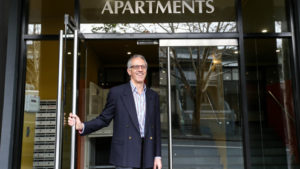
To investigate how private sector apartment buildings can contribute to a vision of Sustainable Sydney 2030, the City piloted the Smart Green Apartments programme with 30 buildings between 2011 and 2013. This sought to guide multi-apartment buildings to decrease energy and water consumption and waste outputs through free audits and information on government rebates.
With up to 73% of its residents living in apartments, many of which are towers, Sydney is often referred to as ‘the Vertical City’. These residential buildings account for 10% of the City’s GHG emissions, 38% of its water use and 14% of its waste. City data predicts that half of the population in the state of New South Wales (NSW) will be living in apartments by 2030. In response to this situation, the City launched the Smart Green Apartments (SGA) Programme in 2011 to help apartment owners and managers to reduce energy and water use, minimise waste and GHG emissions, and improve environmental sustainability. The programme consists of despatching professional auditors to selected residential apartment buildings to conduct sustainability assessments and investigate potential improvements regarding water and energy consumption, renewable energy and waste. Participating building owners and managers receive the following benefits:
- free water and energy audit of building, including performance indicators monitoring and efficiency plans
- assessments of waste and recycling practices
- action plan with retrofitting recommendations
- business case information on capital costs, projected savings and pay back periods, and government rebates
- knowledge and capacity building
Pilot Results
On average, energy savings of up to 30 per cent were identified across the buildings in the program, potentially reducing carbon outputs by one third. Possible areas of savings included:
- lighting retrofits, including controls and sensors
- efficiency upgrades to pool heating systems and covers
- variable speed drives on pumps and fans
- grid connected solar photovoltaic
In deciding which changes to implement first, most apartments looked for the best return on investment – with common area lighting usually being the first change made. In many cases, these had a payback period of two years or less.